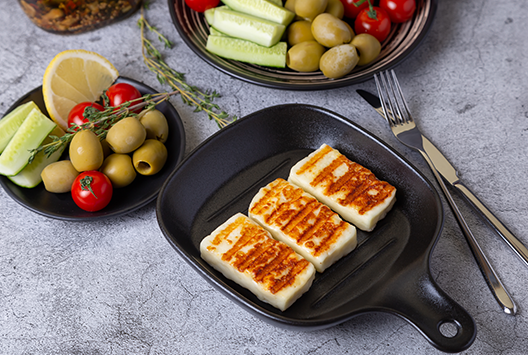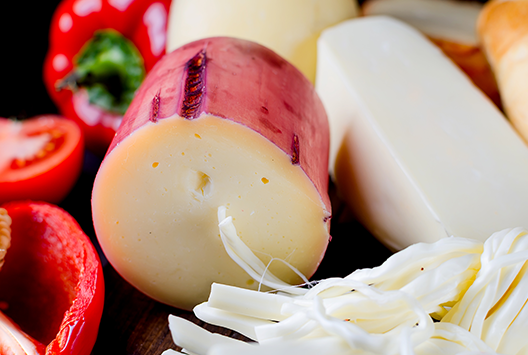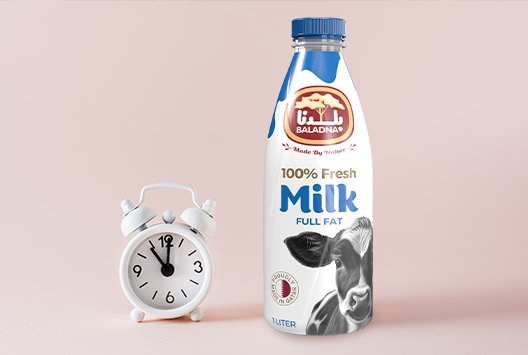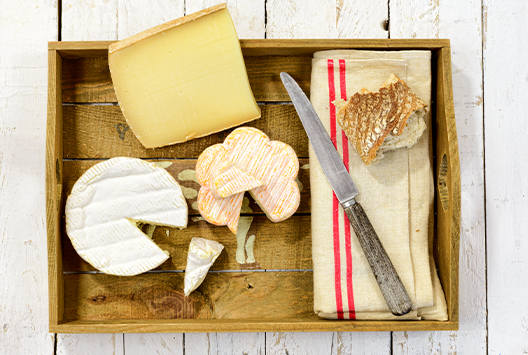
7 Best Side Dishes to Serve with Halloumi Cheese
Similar
When it comes to the world of cheese, halloumi cheese easily steals the show – it’s firm, it’s delicious, and it can be cooked in so many different ways. Whether you're in the mood for grilled cheese or raw cheese, halloumi is the perfect choice. And on top of all that, its salty flavor makes it a great addition to a variety of different side dishes.
If you're looking to take your halloumi game to the next level, we've got your backs. Here are the top seven side dishes that go perfectly well with halloumi cheese:
1. Tomato Zaatar Soup
Tomato Zaatar Soup is a delicious side dish that goes really well with halloumi cheese. This soup is made with tomatoes, onions, garlic, and a variety of spices, including zaatar, a Middle Eastern spice blend that is made up of thyme, sumac, and sesame seeds. The zaatar's nutty flavor pairs well with fried bite-sized halloumi cheese.
2. Pasta with Cherry Tomatoes & Mint
Pasta with cherry tomatoes and mint is the perfect side dish to pair with halloumi cheese. This delicious dish combines the salty, savory flavor of halloumi with the freshness of mint and the sweetness of cherry tomatoes.
Simply cook your favorite pasta according to the package directions, and when it’s done, toss it with a mixture of cherry tomatoes, fresh mint, garlic, olive oil, and a pinch of salt and pepper. Serve it alongside your grilled halloumi cheese and watch your taste buds go on an adventure!
3. Couscous Salad
Not only is couscous salad delicious and easy to make, but it also pairs perfectly with halloumi cheese. To start, boil one cup of couscous in two cups of water. Once cooked, toss in tomatoes, cucumbers, red onion, olives, and crumbled feta cheese. Top it off with a simple olive oil and lemon juice dressing. Serve it with grilled or fried halloumi on top or on the side.
4. Rice Pilaf
Rice pilaf is a classic side dish that pairs perfectly with halloumi cheese. It is made by cooking rice in a flavorful broth and a variety of herbs, spices, and vegetables. To start, sauté some onions, garlic, and other veggies in a pan. Once soft, add the rice and cook until tender. Add a flavorful broth, herbs, and spices, and serve with fried or grilled halloumi.
5. Grilled Vegetables
Grilling vegetables is a great way to add flavor and nutrition to your meals. When served alongside halloumi cheese, grilled vegetables are an irresistible combination. Try grilling eggplant, bell peppers, asparagus, mushrooms, or zucchini to serve alongside halloumi cheese until they are tender and lightly charred. Grilled vegetables provide a great contrast in texture and their smokiness pairs perfectly with grilled halloumi cheese.
6. Roasted Potatoes
Roasted potatoes are a delicious and easy side dish to serve with halloumi cheese. To make, cut potatoes into wedges or cubes, toss with olive oil, salt, and pepper, then roast at 400°F for about 30 minutes or until golden brown. Serve with a sprinkle of fresh parsley, the perfect addition to fried halloumi cheese.
7. Sweet Chili Mayo
Nothing goes better with fried halloumi cheese than a delicious dipping sauce. Sweet chili mayo is a simple dipping sauce that will take your cheese platter to the next level. To make, mix together mayonnaise, sweet chili sauce, and lime juice in a bowl. The mayo provides the creamy texture, the sweet chili sauce adds a bit of sweetness and a hint of heat, and the lime juice brings it all together with a bright acidity.
Halloumi cheese is the salty partner you’ve been looking for
Halloumi cheese is a delicious addition to any meal, thanks to its salty and savory flavor. So wait no longer, it’s time to get cooking and enjoy the deliciousness of halloumi!
Are you looking for premium dairy products? If so, Baladna is your best option. We are the leading dairy company in Qatar, offering an extensive range of products including fresh milk, cheese, yoghurt, and cream. Our dairy products have become staples in many households in Qatar due to their high quality and taste. Whether you are looking for halloumi, feta cheese, or any other cheese, we are the perfect choice. Browse through our list of cheeses today!



